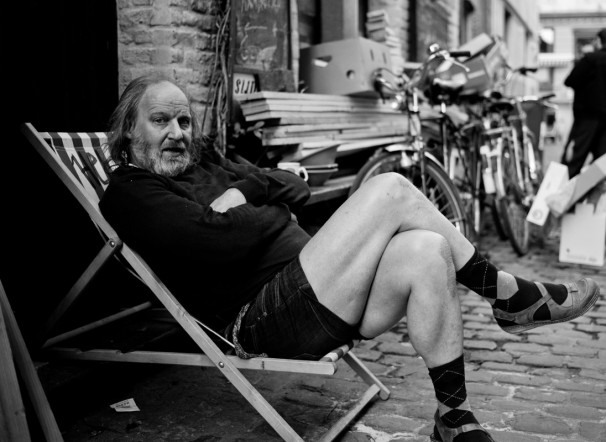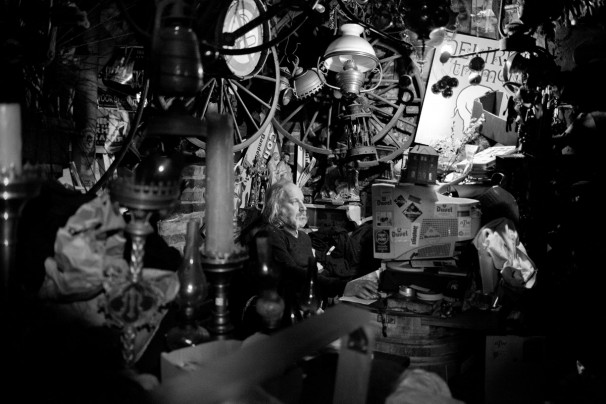“It was like a cave, dimly lit,
everything covered in dust.
The ceiling was just packed with bikes”
Isaiah, Patrick, and Heather had found it first, tucked in an alley along the canal. They were sitting in the cobbled alley in low yacht chairs. The only outside indication that there was even a bar there was an ordinary Delirium Tremens sign. Next to the delirium sign on a propped open door was a hand-painted sign that read simply: UPS HERE BEER DOOR OPEN. The building itself was from the 15th-century, nestled comfortably in an alley between similarly worn buildings and the vaguely hip restaurants and shops of the sort that lined most of the nearby streets in the lively neighborhood. This was Het Velootje Gent, owned by Lieven de Vos.
The Heroes had been steered to this bar cum bicycle museum while visiting Plum-Gent, a bike shop in Gent with a history dating back to the turn of the last century. This history is on display with a basement museum full of examples of old Tour racing machines, including some of Plum-Gent’s line of “Plum-Vainquer” race steel. The sight of any one of these bikes would set any cyclist’s heart racing. The fact these are merely the dusty collection of a bike shop shows you how deep the cycling tradition runs in Belgium. The warm and proper, French-speaking shop owner Pierre gave the Heroes a tour around the shop. He pulled out dusty framed photos and propped them on the counter. The yellowed, black and white photos showed hard faced men standing behind original frames built by Plume. In heavily accented French, Pierre described the shop name’s somewhat dandyish origin as a double for a feather in the cap. The Heroes were in awe.
A thought occurred to Pierre as he was talking, and he turned to his wife doing the books at a nearby desk behind the counter. There was a quick exchange in French and she smiled broadly, chortled, and shook her head. Pierre turned back to the Heroes “I am going to send you someplace very special. You guys like old bikes; this place is a very special place. A bar with bikes from the Napoleonic wars.” His wife laughed loudly, “ Just don’t drink from the glasses,” she interjected, “yes. …it’s a bit..aah..dirty. Just drink from the bottles. But it’s a very special place.. a legendary place for cycling in Ghent.”
Pierre wrote down the address on some shop stationary, and the next evening the Heroes had made their way to the alley where the bar stood. Patrick and Heather were sipping from, by all appearances, clean globular glasses leaning back in the pleasant evening light. “Go inside, go inside.” Patrick motioned. Lievan beckoned us to go inside as well saying, “Come in, come in. I have Delirium on tap.” The narrow entrance was dark and cluttered. Medieval Gregorian chanting could be heard loudly from the darkness inside. It took a while to adjust to the dark. We shuffled through narrow passages navigating mysterious dense piles. It became instantly clear that Luiven was a hoarder. There were piles of papers and trinkets, cans, game-boards and brass-work, and most remarkably vintage bikes, a boneshaker.
There was stuff everywhere, bikes hanging from the ceiling, bikes leaning against the wall, various dusty parts on the floor. We’d stumbled upon the personal space of someone who had spent years accumulating and collecting everything he could get his hands on that was old and bike-related. In addition, there were beer signs and old, broken oil lamps. And everything was under what seemed like a quarter-inch of dust. Along one wall, in amongst the detritus was the bar. The bar consisted of a piano bench with some railroad ties on top, coated in melted candlewax, and a small pony keg of Delirium next to it. At this point Todd got a good look at the glasses and while cloudy were merely typical beer glasses that were just scratched to hell, not exactly as scary as we were led to believe they would be. The beers were not inexpensive, costing a few Euro more than any beer the Heroes had in Belgium. But the cost could be interpreted as a donation to the Lievan de Vos Cycling Museum’s operating budget. And the museum/bar was incredible; a strange wonderful shrine to the sport.
Lievan himself was incredible as well – a tall brute of a man. He had on short shorts, a sash, and mary janes with socks pulled high. He was a thorough eccentric. The Heroes asked him if he had ever raced and he only scoffed saying that he was only into older bikes. Despite never being a racer he had shaved legs. There was something foppishly medieval about him. He looked like Robin Hood in a lazily costumed community theater production.
Lievan’s museum is such a cycling must-see. It’s not organized; it’s a complete mess. However, it’s a representation of one man’s fanatical dedication to cycling and such a specific era of cycling. A trip to Gent without a visit to the Het Velootje Gent would be (like going to the moon without a visit to the Sea of Tranquility) a shame; it’s that special of a place.
Story by Ben Gill and Robert Zach Thomas. Photographs by Isaiah Jay







